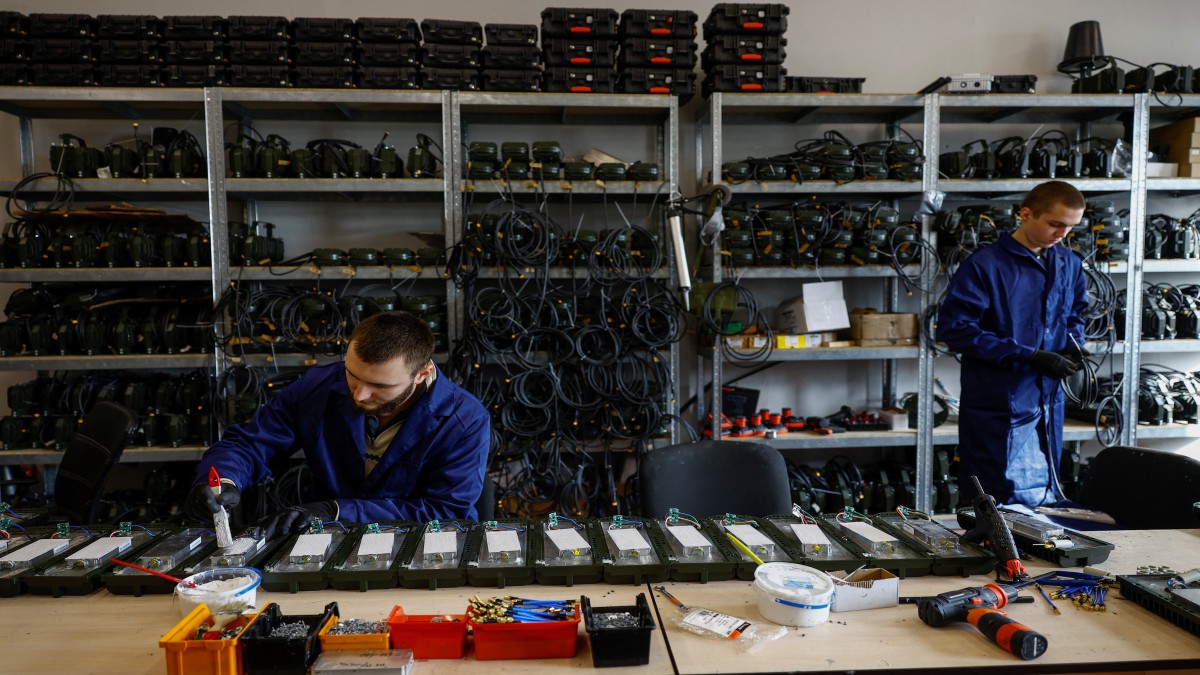Ukraine marked Tuesday the 1,000th day since Russia launched its full-scale invasion in February 2022.
Thousands of Ukrainian citizens have died; over six million live as refugees abroad, and the population has fallen by a quarter since Kremlin leader Vladimir Putin ordered the invasion by land, sea and air.
As losses mount and exhaustion sets in, both sides in the war are trying to replace humans with machines.
Here’s all we know about it.
Arms innovation
According to Yuriy Shelmuk, who co-founded a company last year that produces drone signal jammers, there was not much demand for the devices. It currently has a six-week waiting list and produces 2,500 a month.
Demand shifted after the failure of a major Ukrainian counteroffensive in the summer of 2023 that was meant to put invading Russian troops on the back foot.
Kyiv pointed to Russia’s massive use of troops and landmines, as well as its widespread use of unmanned airborne vehicles to locate and attack sites.
“Concentrated, cheap aerial drones stopped all our assaults,” Shelmuk told Reuters. “There was an understanding that a new game changer had appeared.”
Many of the more than 800 companies in Ukraine’s rapidly growing defence manufacturing sector were established following Russia's full-scale invasion in 2022 .
Many, for example, drones — first in the air, later on land and at sea — as well as anti-drone devices and, increasingly, artificial intelligence (AI), were established in response to the quickly changing battlefield conditions.
“The Ukrainian military-industrial sector is the fastest-innovating sector in the entire world right now,” said Halyna Yanchenko, a Ukrainian lawmaker who has advocated for local arms manufacturers in parliament.
Expanding drone production
This year, Russia and Ukraine are expected to produce over 1.5 million drones, mainly small “first-person view” vehicles that can be remotely controlled to locate and strike enemy targets. These drones cost a few hundred dollars each.
Ukrainian forces told Reuters in February that it was more difficult for them to move freely and build fortifications because of the overwhelming number of Russian drones.
Impact Shorts
More ShortsBy summer, Russia was annexing Ukrainian land at a rate that had not been seen since the beginning of the conflict. This time, however, the majority of the damaged military pickup trucks had electronic warfare (EW) domes, which were previously reserved for expensive equipment.
Shelmuk’s company, Unwave, is one of about 30 companies that produce these technologies, which interfere with drone computer systems by blocking signals and using other techniques.
Due to the reason that most anti-drone EW systems jam one or, at most, a few radio frequencies, Russian drone operators can avoid jamming by switching to a different frequency. To determine which frequencies their drones will utilise, EW manufacturers thus keep an eye on online conversations pertaining to Russian drones.
‘War of robots’
Both sides of the conflict are attempting to replace people with machines as casualties increase and exhaustion creeps in.
Russia has allegedly turned to North Korea as Ukraine has struggled to resupply units that have been depleted over time by conflict.
According to seven officials and companies who spoke to Reuters, battlefield innovation in the upcoming year will primarily concentrate on automation.
“The number of infantrymen deployed in trenches has decreased significantly, and combat command is possible to do online from a remote point, which reduces the risk of personnel being killed,” said Ostap Flyunt, an officer in the 67th mechanised brigade.
According to state-sponsored defence accelerator Brave1, Ukraine currently has over 160 companies producing unmanned ground vehicles.
They can be used to transport remotely operated machine guns, supply supplies, and evacuate injured people.
Hephaestus, an army colonel, recently resigned from the military to begin developing automated machine gun systems.
He said that human gunners on the front were already being replaced by six of his products, which enabled them to control the weapons from a screen located far from any risk.
Flyunt said this was increasingly common: “Modern war is a confrontation of technologies for detection, jamming, and destruction at a distance, leaving to the operator only the ability to make decisions about strikes,” he said.
Arms minister Herman Smetanin also said remote warfare, including using artificial intelligence, was on the increase.
“In the near future, this will be the main direction of development, the war of robots,” he told Reuters. “It’s about people’s lives, we need to protect them.”
Ukraine hopes that a cutting-edge defence industry will provide its invasion-destroyed economy a fresh start.
Although the country still depends on its Western partners for air defences, missiles, and shells, it has invested $1.5 billion in modernising the defence industry that had stalled since the Soviet era, according to arms minister Smetanin.
The minister claimed that Ukraine can only afford to purchase almost half of the $20 billion in defence production capacity that has increased from $1 billion in 2022 to $20 billion in 2024, leaving the additional manufacturing capacity unutilised.
President Volodymyr Zelenskyy has stated that he plans to address the issue of manufacturers’ complaints regarding strict profit margin limits and the absence of long-term state procurement contracts.
According to the four companies Reuters contacted, they also had trouble hiring enough skilled workers.
Kateryna Mykhalko, director of Tech Force in UA, an association of private defence manufacturers, said 85 per cent of 38 firms surveyed by her organisation were either considering relocating operations abroad or had already done so.
For many, the most difficult problem is a wartime arms export ban that companies want lifted so they can raise money for growth. Officials are worried about the public’s reaction to a war-torn nation that exports weapons.
With inputs from Reuters


)

)
)
)
)
)
)
)
)



